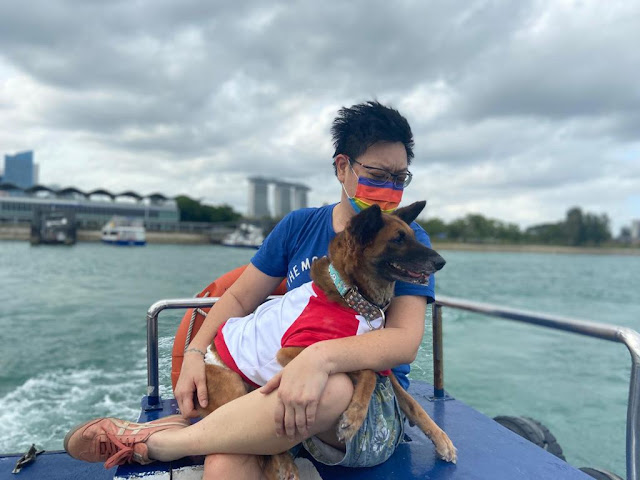How can this be love?
 |
| Her neck no longer had any fur - just thick crusty skin. |
\We heard about this dog and have been trying to persuade her owner to hand over to us but she had been putting it off with a whole lot of excuses – work, busy, my kids will miss the dog etc. We continued to try and persuade her and we are glad we did. Our persistence paid off. She finally agreed to surrender the dog to us.
 |
| Limited vision and terrible skin |
Little did we know what a sorry state the dog was in.
Chelsea is 10, given up twice, but we are certain this will be third time lucky for Chelsea.
Like all our rescues, they are taken to the vet immediately for a full medical. We spare no expense at ensuring their well-being.
One look at Chelsea would bring tears to your eyes. How did she even live for so long in that state? Her condition was far worse than a breeding dog and yet, she had an owner!! Neglect is also a form of abuse.
While waiting at the vet, Chlesea scratched till she cried in pain and frustration. Her neck no longer had fur – it was just thick and crusty from years of scratching. YEARS!
Her nails! How to even walk without pain??
 |
| Just look at her nails!! How to walk like that?? |
Grossly underweight at just 4.4kg – she needs to put on another 2 to 3kg at least. We were told she was fed white rice – that would explain her horrible skin infection and malnutrition.
 |
| Chronic ear infection |
 | |
|
Severe malnourishment and dehydration. Did they even remember to feed her? She was so dehydrated that she needed to be put on drip immediately.
Her kidneys are starting to show changes – not yet kidney failure but she needs to start taking in lots of fluids so that her kidneys hopefully start functioning normally again.
Anemia. This could be caused by her malnutrition and chronic skin issues.
Bad teeth – she will require dental at a later stage, when she is stronger.
Luxating patella in both her hind legs. She will require hydrotherapy and long slow walks to build muscles to hold her joints in place.
 |
| A shadow of a dog |
Painful, curved spine – we are unsure if she was caged and thus her curved spine.
Arthritis – she was given a jab for her painful joints; oh, and a jab for her itchy skin.
Cataracts in both eyes with limited vision.
Irresponsible humans have failed this little dog; not once, but twice, and made her life a living hell. But dogs are resilient and so forgiving and Chelsea is the sweetest, little dog you will ever know. So kind, so tolerant and you can see it in her blurred eyes that she is willing to let go of her sad past and move on.
For now, she just loves her food – you won’t believe how happy she is just being in our volunteer’s home, going for walks and eating nice home cooked meals.
To help with Chelsea’s vet bills, please email hopedogrescue@singnet.com.sg
She will be put up for adoption when she is ready and like all our rehoming cases, we will be very stringent on our screening because Chelsea’s life is in our hands and it is our responsibility to ensure she will be treated like a little princess till the end of time.



















